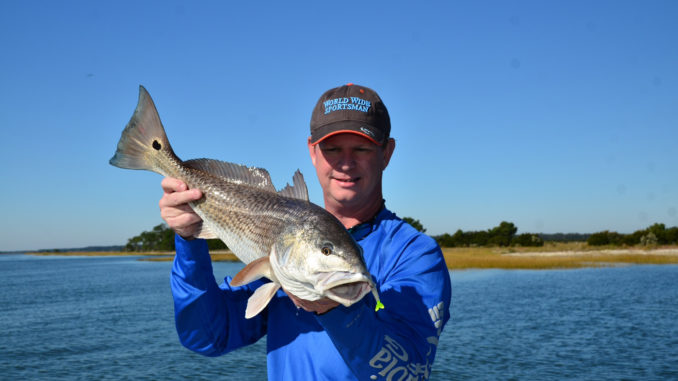
With water crystal clear, sight-fishing is tops
Cold weather has been here for a while, and while these chilly days aren’t the most comfortable for anglers, they can provide some great inshore fishing. This time of year typically brings less rainfall than South Carolina has had in months, and along with vegetation that has died or is dying back due to the cold, that means crystal-clear water is usually easy to find. This is a plus for anglers, but not all anglers know how to take advantage of clear water.
Redfish are one of the main targets that inshore anglers pursue heavily in December. They begin stacking up in large schools and are easy to spot in clear water, but the clear water helps them see, too, so they are often more wary than ever. If they see anglers first, getting them to bite can be a challenge that is tough to overcome.
“The schools can number 500 fish and more,” said Capt. Charlie Beadon of Beaufort Sport Fishing. “The sheer size of these schools coupled with the clear water helps anglers see them, even from a distance, and spotting a school is a big part of the battle,” he said.
Beadon said sunny days with little chop on the water offer especially good sight-fishing opportunities, and good polarized sunglasses are a must. Beadon (843-592-0897) likes to pole alongside the schools, keeping his distance while watching them from his elevated poling platform.
“The odds are stacked against redfish this month,” he said. “The porpoises don’t have many food options right now, because a lot of the other fish they eat all spring, summer, and fall have left the inshore waters. They feed voraciously on redfish, which is one reason the redfish stack up in these huge schools.”
The great water clarity doesn’t help the reds’ plight, but it is a plus for anglers.
“Those redfish are going to be in shallow water, cruising in large numbers for safety, and staying in water too shallow for the dolphins to go,” he said.
Once anglers find a school of redfish, Beadon suggests casting in front of the first fish in the school.
“Catching one out of the middle is a sure way to bust a big school up into smaller schools, and those schools will all become harder to find, so I cast to the front of the school,” he said.
Once he hooks up, Beadon lands the fish as quickly as possible, ensuring it doesn’t run back into the midst of the school.
Beadon’s favorite lures on these clear days are soft plastics like Gulp! shrimp and minnow patterns. He fishes them on jigheads and uses spinning reels in the 2000 to 2500 range with 6-foot-6 rods. Interestingly, Beadon opts for monofilament over fluorocarbon leaders when the water is this clear. While fluorocarbon is as clear as water, Beadon said that’s only as long as the line doesn’t get nicked.
“Once fluorocarbon gets a few nicks, which it will around these oyster beds, those nicks refract light far worse than any other line. That’s exactly what anglers don’t want, or expect, to happen when using fluorocarbon line,” he said.
Although these fish are easy to find this month, Beadon said it’s not often that anglers will catch more than a few from each school before seeing the rest of the fish in that school get lockjaw.
“Other big schools are not difficult to find, so once you’ve caught two or three from one school, anglers should move on to another school,” he said.
It’s more difficult to see these schools on overcast days and in choppy water, but anglers can still use their vision to detect them.
“Watch closely for a moving ‘V’ shape on the water’s surface. This is where redfish are pushing water. Casting in front of that ‘V’ will usually land your lure in front of the leading fish,” said Beadon, who cautions anglers against any sudden movements while pursuing these fish.
“(Doing) anything from poling to casting, your movements are magnified because of the water clarity, and sudden movements will put a halt to the bite, or even send the schools into deeper water,” he said.
When these schools go deep or break into smaller schools, Beadon said anglers need not fret.
“It will take a little time, but the schools will form back up again, and it won’t take long for them to be shallow again,” he said.




Be the first to comment